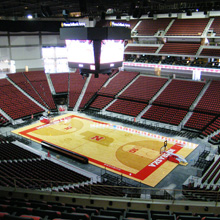 |
| In addition to the sound system, security and access equipment from EV’s parent company Bosch was also installed |
In today’s world of sound reinforcement systems, a PA might be anything from a collection of disparate parts to an integrated whole in which each component is designed to interact seamlessly with all others. While the latter has obvious benefits in terms of performance and flexibility, it’s an approach that can be surprisingly challenging to find in the PA systems offered by leading vendors.
That’s what Chris Chavanu of Electronic Contracting Company (ECCO) in Lincoln, Nebraska discovered when he set out to find the best match for the sound system requirements of Lincoln’s brand-new 15,147-seat Pinnacle Bank Arena, the new home of the University of Nebraska Cornhuskers men's and women's basketball teams. Based on specifications developed under the direction of Kevin Day at Dallas AV consultancy Wrightson, Johnson, Haddon & Williams, the arena’s request for proposals (RFP) favored an integrated single-vendor solution. When the proposals were evaluated, the final selection for the arena’s PA was an Electro-Voice line array system featuring the compact three-way XLD281 element. In addition to the sound system, security and access equipment from EV’s parent company Bosch was also installed.
“Ten years ago there wasn’t much integration available for large arena systems, but these days we know that the technology is available,” says Chavanu, who oversaw ECCO’s design-assist and installation responsibilities on the project. “So when we issued the RFP for a line array system with satellite speakers, we wanted everything from one source, not just the loudspeakers but also digital signal processing, power amplifiers and amplifier monitoring. That gives us a single company to deal with for communication, integration, support and service.”
The RFP process allowed for a half-dozen of the industry’s leading PA brands to submit proposals. “Most of them were eliminated from consideration,” Chavanu says, “because there were only two that were really able to meet the design guidelines completely by delivering a fully integrated system.” In the end the Electro-Voice proposal carried the day, which was particularly fitting because the company has a local manufacturing and service presence right in Lincoln. Lin Buck of Electro-Voice sales, along with technical support engineers such as Stu Schatz, George Georgallis and Chris Aeilts, worked closely with ECCO and WJHW to shepherd the installation from design to successful completion.
XLDs at the core
The core of the WJHW-designed system is six XLD281 arrays of eight elements each, flown around the central scoreboard. The XLD281’s 120-degree coverage pattern allows the short sides of the room to each be covered with a single array facing straight out. The four remaining arrays are each flown at a corner, angled such that the long sides of the room are each covered by a pair of arrays. “The XLDs do a great job of providing coverage at long distances,” Chavanu says. “They’ve got the high directivity, high output and high intelligibility that we need. There is certainly more performance and value in the XLDs compared to similar-sized models from other brands.”
Power for the arrays is provided by a dozen Tour Grade series TG5 2,000 watt-per-channel amplifiers “The Tour Grade amps are among the best-performing amps in our industry,” Chavanu says. “They are incredibly stable, very high output, very high efficiency and they sound amazing.”
Each TG5 is equipped with an optional RCM-28 – the latest generation remote-control DSP module from EV. RCM-28 is a dual-channel DSP and control module for Tour Grade amps that supports Bosch’s OMNEO media networking architecture, which combines Dante audio networking with the OCA control networking platform.
"There is certainly more performance and value in the XLDs compared to similar-sized models from other brands" |
Amplifiers with RCM-28 modules installed can be integrated into OMNEO networks that operate over standard Ethernet and can interoperate with Dante and OCA enabled products from any manufacturer. With an RCM-28 module installed, network, audio, and system parameters can be completely supervised and controlled remotely through IRIS-Net software.
“The RCM-28 provides FIR filters for the XLDs,” Chavanu says, “and it lets us connect the amps to the arena’s AV network for control, monitoring, DSP and digital audio over Dante, all running on one Ethernet network.” Also connected to the AV network are five NetMax N8000 digital matrix controllers that route audio throughout the facility. “NetMax is a great DSP platform,” Chavanu says. “It has maturity in the industry, it’s fully integrated with the Tour Grade amps, it supports Dante and CobraNet, and it sounds great.”
Near but slightly inside of the array positions are a dozen XCS312 triple-12-inch cardioid bass elements. The subwoofers are flown in four hangs of three each, powered by a total of eight CP3000S power amps. Chavanu says that the cardioid design and array-independent positioning combines to create more low-frequency directionality compared to a traditional subwoofer flown as part of the main array. “It allows more energy to come out the front of the subs, so we energize the seats more and put less lows on the floor and ceiling.”
The main floor (court) is covered by full-range loudspeakers, specifically EVH1152 two-way coaxial horn-loaded cabinets in a 60 x 60 coverage pattern. Additional EVH1152s, in both 60 x 40 and 90 x 40 patterns, are used for the satellite speakers in the delay ring that covers the arena’s upper level seating. In all, a total of 34 EVH1152s are powered by 19 CPS 2.12 amps from the Contractor Precision series. “The 1152s are designed to maintain their directivity down to 400 Hz,” Chavanu says. “That’s very unusual for that kind of horn-loaded box; most are only directional down to about 1,500 Hz.”
EVIDs for distributed sound
In addition to sound within the main arena, Electro-Voice was also chosen to provide distributed sound in the building’s public spaces such as lobbies, the concourse level and concessions. About 200 of Electro-Voice’s EVID loudspeakers are used in the distributed system, which is powered by two CPS 4.5 power amplifiers.
When not in use for Cornhuskers basketball, the arena will be busy with commencements, trade shows and concerts as well as diverse events such as circuses and rodeos. It’s also slated to be used for UN’s planned addition of hockey to its lineup of school sports. While old-school arenas are often large, boxy, echo-chambers, Chavanu says WJHW created an excellent design in which the space and sound system work together to deliver both power and intelligibility.
“WJHW did an outstanding job designing not only the natural acoustics of the space, but also the sound system,” Chavanu says. “The performance requirements have definitely been met, and the customer has told us that they are very pleased not only with the speech intelligibility and the high output capacity of the EV system, but also with the fact that we can achieve that without over-energizing the room. When you can deliver high SPL and high intelligibility in an arena, you’re going to have a satisfied customer.”




